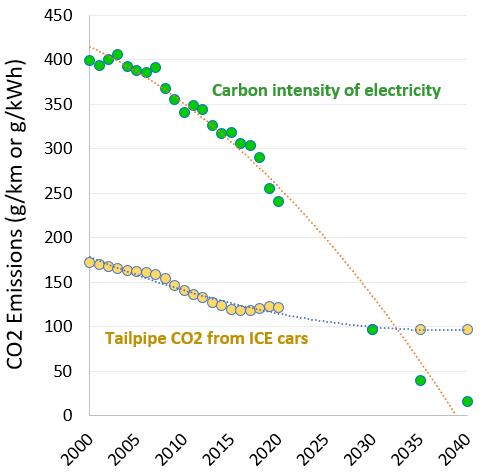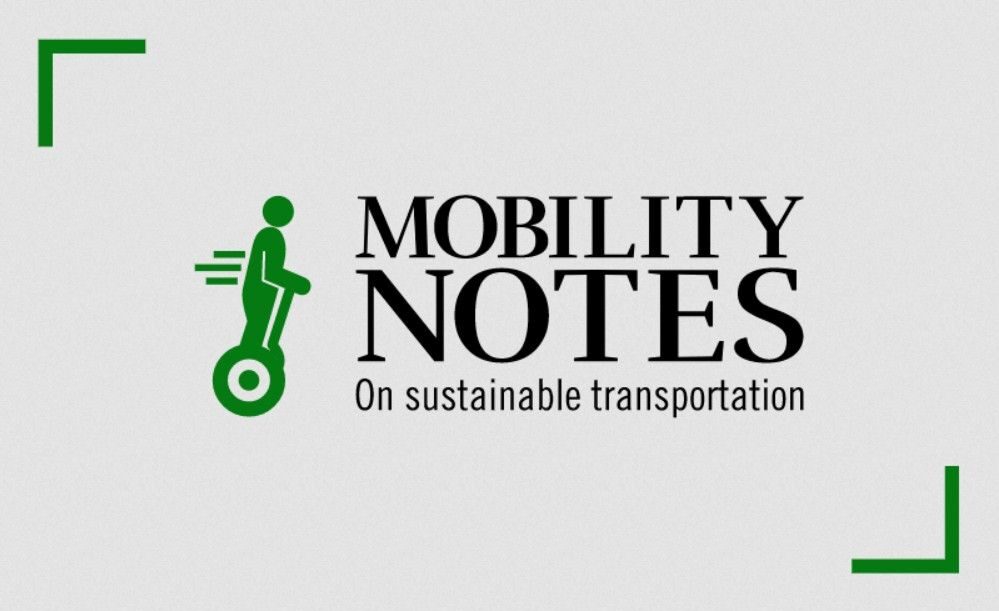Importance of wells-to-wheel accounting of CO2 emissions from the transportation sector
First some good news
After a few years of no improvements in tailpipe CO2 emissions, Europe has recorded a significant reduction in CO2 from passenger cars. The European Environment Agency (EEA) has published its provisional data on CO2 emissions : the average emissions for new cars registered in the European Union, Iceland, Norway and the UK were 107.8 g/km in 2020, which is a whopping 14.5g or 12% lower that in 2019. This was helped by a surge in electric vehicle (EV) sales, which tripled from 3.5% in 2019 to 11% in 2020.
Next some not-so-good news
Considering that EVs are currently certified at zero g/km of CO2 emissions, this means that the actual reductions from the internal combustion engine (ICE) portion of the fleet was lower. Doing a simple averaging (89% ICE, 11% EV) shows that the ICEs emitted ~ 121 g-CO2/km, which is a measly 1.3 g/km reduction from the prior year. In other words, sales of EVs have helped OEMs meet the CO2 targets without making much improvements in the fuel efficiency of ICE cars.
But things do get better – provided electricity continues to get cleaner
First some background data and assumptions:
What happens when you include the CO2 emissions associated with upstream generation of electricity used to charge the EVs ? For that, let’s look at both the improvements in the fuel economy of ICE cars and the carbon intensity (measured in gms of CO2 per kWh) of the electricity generation. The plot shows both of these for Europe.
Some comments –
(1) The 2020 number for CO2 emissions from cars is adjusted to account for 11% EV penetration (see section above)
(2) By 2030, ICEs are assumed to get 20% more efficient (think hybridization) and then there is no further improvement beyond 2030.
(3) The 2020 number for carbon intensity is extrapolated assuming the same rate of improvement as in the previous year (from 2018 to 2019, which was a good year)
(4) The 2030 number is taken from the EEA target for meeting the 55% reduction in greenhouse gas emissions in that year compared to 1990 levels.
(5) The 2035 – 2040 projection assumes that the grid gets cleaner at the same rate as in the previous decade.
References:


So how do the overall CO2 emissions look like ?
Again let’s start with some basic assumptions made here:
Number of cars sold in Europe each year : 15 million
Annual distance driven : 13,000 km
Energy consumption for EVs : 16 kWh/100km (25 kWh/100mi, which is near the best for EVs today – Tesla Model 3 is 24 kWh/100mi, Tesla Model S is 28 kWh/100mi)
Also assumed is that no new ICEs are sold beyond 2035 (all electric sales).
CO2 emissions are calculated using the numbers shown in figure above using the following:
CO2,fleet = CO2,ICE + CO2,EV
= [# ICEs sold x Tailpipe CO2, g/km x Distance travelled, km/yr ] + [# EVs sold x Energy consumption, kWh/km x Distance travelled, km/yr x CO2 for grid, g/kWh]
The plot here show calculations for CO2 emissions from the entire fleet. Both the “tank-to-wheel” and “wells-to-wheel” emissions are seen to decrease with time. The former reaches zero in 2035, where the assumption is that the entire fleet goes fully electric.
Adding the upstream CO2 associated with electricity generation leads to slightly higher values as expected but reach zero beyond 2040 when the grid is entirely renewable.
Of course this is only part of the story. Globally, when including the entire fleet and other modes of transportation and accounting for an increase in the number of vehicles Bloomberg predict in their EV Outlook an increase in CO2 emissions from the global transportation sector, peaking around 2030.
So what does this mean?
The above analysis shows that if we couple EV sales with an improving grid, we can substantially reduce the CO2 emissions from the fleet by say 2050 or so when the grid gets completely clean. The argument then, is to get on with the EV transition and not wait for the grid to get clean. However, it is important for two things to happen from a policy perspective:
(1) Start accounting for upstream CO2 emissions. This will help track the real progress and make sure that we are not shifting CO2 from tailpipe to powerplants. Ultimately the assumption made above on the grid getting cleaner with time is likely true but the pace could be very different and it is important to track the real reductions.
(2) CO2 standards should be set such that they also motivate ICE improvements. What is not shown in this analysis is that there are going to be hundreds of millions of ICEs on the road in 2040 – 2050 and unless they are running on cleaner, more efficient engines, we will have lost a significant opportunity for reducing cumulative CO2 emissions from the transportation sector. Consumers should also be incentivized to purchase hybrids, which will offer some reduction in CO2 while we transition to EVs.
(3) And this is perhaps the most important but also the no-brainer conclusion – we have to focus on getting the grid clean, without which this whole exercise in electrification is pointless.
Other recent posts
NOx emissions inventories – Role of improved HD ICE technologies
![]()
A new in-use emissions study on heavy-duty vehicles shows that both conventional diesel and alternative fuel vehicles certified to the 0.02 g/bhp-h standard can meet future EPA NOx limits even in day-to-day operation.
Conference Summary – SAE WCX 2025
![]()
A summary of the “SAE WCX 2025” conference held in Detroit.
IRENA Renewable Energy Capacity Statistics 2025
![]()
According to the latest report from IRENA, 2024 saw the largest increase in renewable capacity, accounting for 92.5% of overall power additions.
Like it ? Share it !

